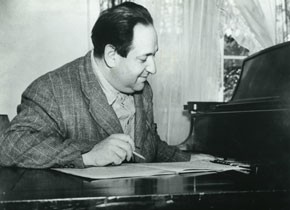Erich Wolfgang Korngold
Scoring for Warner Bros.
November 16 to 30, 2007
For the first time in its history, the Film Museum presents a show devoted to the work of a film composer. Erich Wolfgang Korngold’s achievements as an artist-in-exile in Hollywood – from 1935 to the mid-1940s – have been widely appreciated as a landmark in the development of "music for the movies”.
A musical wunderkind, the Austrian Korngold was already well established as a composer of operas and orchestral works when he arrived in Hollywood. He was the first "serious" composer of international reputation to close a contract with the American film industry.
Together with such colleagues as Max Steiner, Franz Waxman, Hans Salter and Miklós Rózsa, who, like Korngold, came from a traditional Central European musical background and were shaped by Late Romanticism, he created the symphonic idiom which eventually epitomized the classic "Hollywood Sound" and continues to enjoy widespread favour in film scoring practices today.
The Special Contract he had with Warner Bros. permitted Korngold, unlike his colleagues, to concentrate on just a few select projects. He owes his fame to a relatively small number of film scores which he worked out with untypical complexity and minute attention to detail. After his much-admired Hollywood début with the arrangement of Mendelssohn's music for Max Reinhardt's Shakespeare adaptation A Midsummer Night's Dream (1935), Korngold mostly concentrated on adventure films and historical subjects which offered ample opportunity for his operatic approach to shaping the music.
His scores were compared to the music of Richard Strauss and Gustav Mahler, and his romantic theme for the swashbuckler The Sea Hawk (1940) was ranked on a par with Wagner's "Liebestod” from Tristan und Isolde.
In addition to the two films mentioned above, the Retrospective will present all of Korngold's major Hollywood films, from the classic Captain Blood (1935) to the grim small-town drama Kings Row (1942), from the celebrated, Oscar-winning scores for Anthony Adverse (1936) and The Adventures of Robin Hood (1938) to outstanding literary adaptations such as The Prince and the Pauper (1937), The Private Lives of Elizabeth and Essex (1939) and The Sea Wolf (1941).
The importance of team work in the studio system can be seen in the fact that, again and again, the same collaborators were involved in these films: actors and actresses such as Bette Davis, Olivia de Havilland and Errol Flynn, cinematographers like Sol Polito, Ernest Haller and Tony Gaudio, and especially one director: Michael Curtiz. Like Korngold, he had also come to Hollywood via Vienna, finding his home as an artist at Warner Bros.
Seen in this light, the Film Museum's show is not just a tribute to Korngold's oeuvre. It emphasizes an aspect that is valid for cinema in general: film music is (almost) never autonomous; it is always applied music. Its special character and its individual qualities are only revealed in context with all other levels of expression: the use of image, sound and filmic space, the narrative development, the dynamics of acting.
Thus it makes sense to perceive film music as part of the total cinematographic experience rather than examining it outside of this context. Korngold's scores for Warner Bros. are perfect illustrations of this approach: in order to hear all of its opulence and grasp its true significance, his music has to be seen.
The Korngold Retrospective will take place alongside other events marking the 50th anniversary of Erich Wolfgang Korngold's death. His works are the centrepiece of the gala concert "Hollywood in Vienna" on November 29 in the Vienna Konzerthaus. On November 25, a round-table discussion with Korngold scholars will take place at the Haus der Musik. At Vienna's Jewish Museum, the exhibition "The Korngolds: Cliché, Criticism, Composition" will be shown from November 28 to May 18, 2008.


